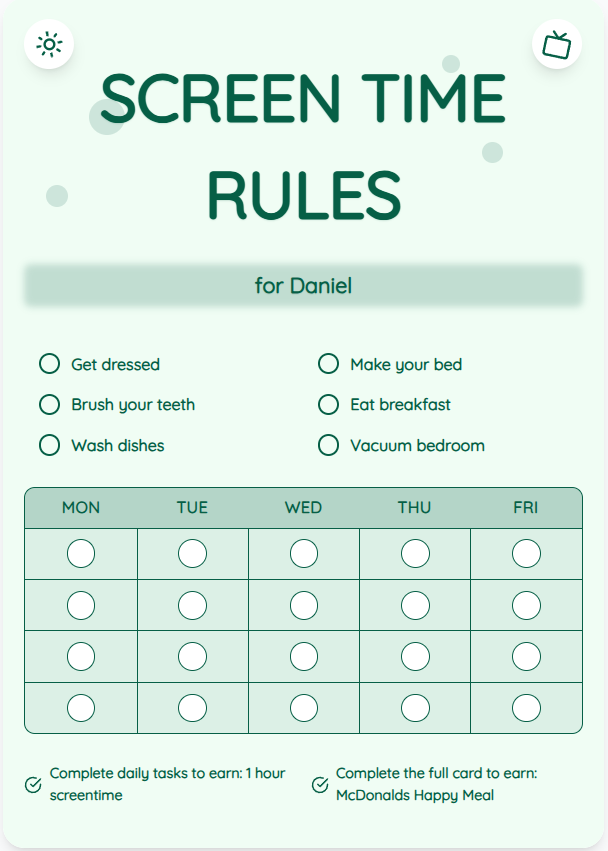How to Set Screen Time Limits for Kids in Virginia
As a parent in Virginia, managing your child's screen time can be challenging. Finding the right balance between technology use and other activities is crucial for your child's development and well-being. In this guide, we'll provide you with practical tips and solutions to help you navigate screen time limits effectively.
See What Your Screen Time Chart Will Look Like
Here's an example of a beautiful, customizable screen time rules chart you can create for your family

Understanding Screen Time Guidelines in Virginia
Virginia does not have specific statewide screen time regulations for children. However, it is recommended by pediatricians that children aged 2-5 should have no more than one hour of screen time per day, while children aged 6-12 should have consistent limits on screen time that prioritize other activities like physical play, social interactions, and educational pursuits.
Practical Tips for Managing Screen Time
1. Create a screen time schedule that includes designated times for tech use and non-tech activities. 2. Use screen time charts to visually represent and track your child's daily screen time allowance. 3. Encourage outdoor play, reading, and hobbies to reduce dependence on screens. 4. Set a good example by modeling healthy screen habits yourself.
Put These Tips Into Action
Create a custom chart to implement these strategies with your child
Setting Screen Time Rules and Boundaries
Establish clear rules around screen time usage, such as no screens during meal times or before bedtime. Communicate these rules with your child and ensure consistency in enforcing them. Be flexible but firm in implementing consequences for exceeding screen time limits.
Utilizing Screen Time Charts for Effective Management
Screen time charts are valuable tools that visually represent your child's daily screen time allowance. You can customize these charts based on your child's age, interests, and family routines. By involving your child in the chart creation process, you promote a sense of ownership and responsibility.
Practical Tips for Success
- Create a family media plan to establish clear guidelines on screen time usage.
- Encourage screen-free zones in certain areas of your home, such as bedrooms and dining areas.
- Use parental control features on devices to limit access to inappropriate content and set time restrictions.
- Engage in tech-free activities as a family, such as board games, outdoor adventures, or arts and crafts.
Frequently Asked Questions
How can I handle resistance from my child when enforcing screen time limits?
It's normal for children to resist limits on screen time, but consistency is key. Explain the reasons behind the rules and offer alternative activities. Stay calm yet firm in enforcing the boundaries.
Is it okay to use screen time as a reward for good behavior?
While using screen time as a reward can be tempting, it's important to promote intrinsic motivation in children. Consider using non-screen-related rewards or positive reinforcement techniques instead.
What are the potential risks of excessive screen time for children?
Excessive screen time has been linked to various negative effects on children, including decreased physical activity, poor sleep quality, delayed social development, and potential impacts on cognitive function. Setting limits is essential for their overall well-being.
By implementing practical strategies like creating a screen time schedule, setting clear rules, and utilizing screen time charts, you can effectively manage your child's screen time in Virginia. Finding the right balance will not only benefit your child's development but also foster a harmonious family environment. Visit ScreenTimeRules.com to generate personalized screen time charts and start implementing these solutions today.
Ready to Transform Your Family's Screen Time?
Join thousands of parents who have successfully managed screen time with our customizable charts.
